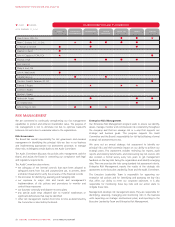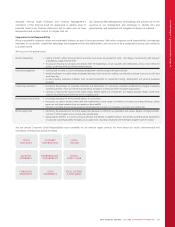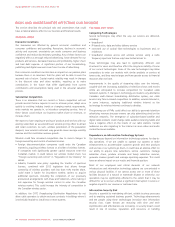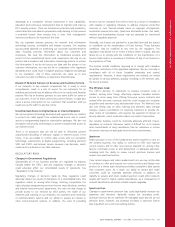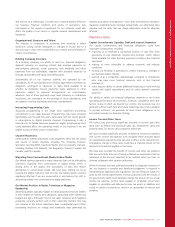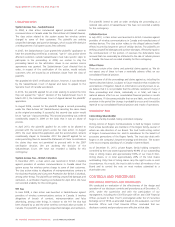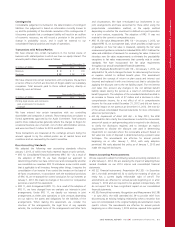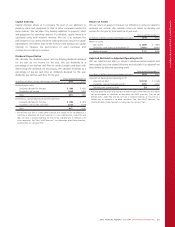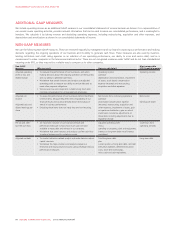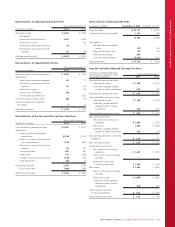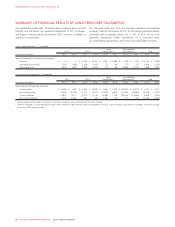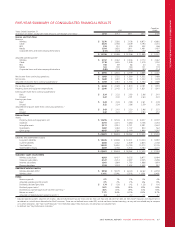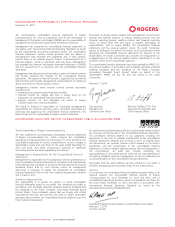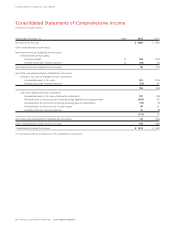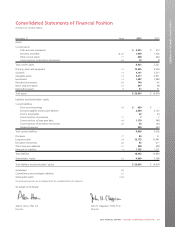Rogers 2013 Annual Report Download - page 86
Download and view the complete annual report
Please find page 86 of the 2013 Rogers annual report below. You can navigate through the pages in the report by either clicking on the pages listed below, or by using the keyword search tool below to find specific information within the annual report.
MANAGEMENT’S DISCUSSION AND ANALYSIS
retrospectively. We are assessing the impact of this amendment on
our consolidated financial statements.
•IFRIC 21, Levies (IFRIC 21) – In May 2013, the IASB issued a new
accounting guidance IFRIC 21, which provides guidance on when to
recognize a liability for a levy imposed by a government, both for
levies that are accounted for in accordance with IAS 37 Provisions,
Contingent Liabilities and Contingent Assets and those where the
timing and amount of the levy is certain. The Interpretation identifies
the obligating event for the recognition of a liability as the activity
that triggers the payment of the levy in accordance with the relevant
legislation. It provides the following guidance on recognition of a
liability to pay levies (i) the liability is recognized progressively if the
obligating event occurs over a period of time, and (ii) if an obligation
is triggered on reaching a minimum threshold, the liability is
recognized when that minimum threshold is reached. The standard is
effective for annual periods beginning on or after January 1, 2014,
with early adoption permitted. We are assessing the impact of this
new standard on our consolidated financial statements.
•IFRS 9, Financial Instruments (IFRS 9) – In October 2010, the IASB
issued IFRS 9, which replaces IAS 39, Financial Instruments:
Recognition and Measurement, establishes principles for the financial
reporting of financial assets and financial liabilities that will present
relevant and useful information to users of financial statements for
their assessment of the amounts, timing and uncertainty of an
entity’s future cash flows. This new standard also includes a new
general hedge accounting standard which will align hedge
accounting more closely with risk management. It does not
fundamentally change the types of hedging relationships or the
requirement to measure and recognize ineffectiveness, however it
will provide more hedging strategies that are used for risk
management to qualify for hedge accounting and introduce more
judgment to assess the effectiveness of a hedging relationship. The
mandatory effective date of IFRS 9 has not yet been communicated
by the IASB. We are assessing the impact of this new standard on its
consolidated financial statements.
KEY PERFORMANCE INDICATORS
We measure the success of our strategy using a number of key
performance indicators, which are outlined below. We believe these key
performance indicators allow us to appropriately measure our
performance against our operating strategy as well as against the
results of our peers and competitors. The following key performance
indicators are not measurements in accordance with IFRS and should
not be considered as an alternative to net income or any other measure
of performance under IFRS.
Subscriber Counts
We determine the number of subscribers to our services based on active
subscribers. When subscribers are deactivated, either voluntarily or
involuntarily for non-payment, they are considered to be deactivations
in the period the services are discontinued.
Wireless
• A wireless subscriber is represented by each identifiable telephone
number.
• We report wireless subscribers in two categories: postpaid and
prepaid. Postpaid and prepaid include voice-only subscribers, data-
only subscribers, and subscribers with service plans integrating both
voice and data.
• Wireless prepaid subscribers are considered active for a period of 180
days from the date of their last revenue-generating usage.
Cable
• Cable Television and Internet subscribers are represented by a
dwelling unit, and cable Phone subscribers are represented by line
counts.
• When there is more than one unit in one dwelling, like an apartment
building, each tenant with cable service is counted as an individual
subscriber, whether the service is invoiced separately or included in
the tenant’s rent. Institutional units, like hospitals or hotels, are each
considered to be one subscriber.
• Cable Television, Internet, and Phone subscribers include only those
subscribers who have service installed and operating, and who are
being billed accordingly.
Subscriber Churn
Subscriber churn is a measure of the number of subscribers that
deactivated as a percentage of the total subscriber base, usually
calculated on a monthly basis. Subscriber churn tells us our success in
retaining our subscribers. We calculate it by dividing the number of
Wireless subscribers that deactivated (usually in a month) by the
aggregate numbers of subscribers at the beginning of the period. When
used or reported for a period greater than one month, subscriber churn
represents the sum of the number of subscribers deactivating for each
period incurred divided by the sum of the aggregate number of
subscribers at the beginning of each period incurred.
Average Revenue per User
Average Revenue per User (ARPU) helps us identify trends and measure
our success in attracting and retaining higher value subscribers. We
calculate it by dividing revenue (usually monthly) by the average
number of subscribers in the period. For Wireless, ARPU is calculated
using network revenue. When used in connection with a particular type
of subscriber, ARPU is monthly revenue generated from those
subscribers, divided by the average number of those subscribers during
the month.
Average Revenue per User Calculations – Wireless
(In millions of dollars, subscribers in
thousands, except ARPU figures and
adjusted operating profit margin)
Years ended December 31
2013 2012
Postpaid ARPU (monthly)
Postpaid (voice and data) revenue $ 6,470 $ 6,402
Divided by: average postpaid
wireless voice and data subscribers 7,957 7,698
Divided by: twelve months for the year 12 12
$ 67.76 $ 69.30
Prepaid ARPU (monthly)
Prepaid (voice and data) revenue $ 278 $ 317
Divided by: average prepaid subscribers 1,481 1,667
Divided by: twelve months for the year 12 12
$ 15.64 $ 15.84
Blended ARPU (monthly)
Voice and data revenue $ 6,748 $ 6,719
Divided by: average wireless voice and
data subscribers 9,438 9,365
Divided by: twelve months for the year 12 12
$ 59.58 $ 59.79
82 ROGERS COMMUNICATIONS INC. 2013 ANNUAL REPORT


